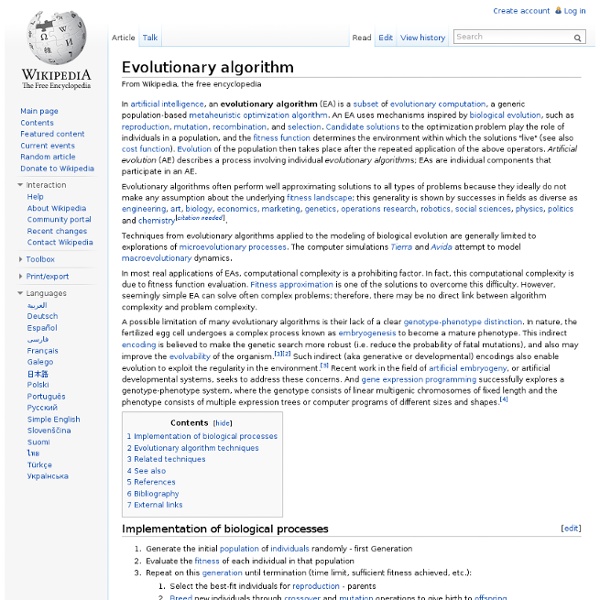Evolutionary algorithm

Genetic algorithm
The 2006 NASA ST5 spacecraft antenna. This complicated shape was found by an evolutionary computer design program to create the best radiation pattern. Genetic algorithms find application in bioinformatics, phylogenetics, computational science, engineering, economics, chemistry, manufacturing, mathematics, physics, pharmacometrics and other fields. Methodology[edit] In a genetic algorithm, a population of candidate solutions (called individuals, creatures, or phenotypes) to an optimization problem is evolved toward better solutions. A typical genetic algorithm requires: a genetic representation of the solution domain,a fitness function to evaluate the solution domain. Once the genetic representation and the fitness function are defined, a GA proceeds to initialize a population of solutions and then to improve it through repetitive application of the mutation, crossover, inversion and selection operators. Initialization of genetic algorithm[edit] Selection[edit] Genetic operators[edit]
Human-based computation
Human-based computation (HBC) is a computer science technique in which a machine performs its function by outsourcing certain steps to humans. This approach uses differences in abilities and alternative costs between humans and computer agents to achieve symbiotic human-computer interaction. In traditional computation, a human employs a computer[1] to solve a problem; a human provides a formalized problem description and an algorithm to a computer, and receives a solution to interpret. Human-based computation frequently reverses the roles; the computer asks a person or a large group of people to solve a problem, then collects, interprets, and integrates their solutions. Early work[edit] Human-based computation (apart from the historical meaning of "computer") research has its origins in the early work on interactive evolutionary computation. A concept of the automatic Turing test pioneered by Moni Naor (1996) is another precursor of human-based computation. Alternative terms[edit]
Artificial neural network
An artificial neural network is an interconnected group of nodes, akin to the vast network of neurons in a brain. Here, each circular node represents an artificial neuron and an arrow represents a connection from the output of one neuron to the input of another. For example, a neural network for handwriting recognition is defined by a set of input neurons which may be activated by the pixels of an input image. Like other machine learning methods - systems that learn from data - neural networks have been used to solve a wide variety of tasks that are hard to solve using ordinary rule-based programming, including computer vision and speech recognition. Background[edit] There is no single formal definition of what an artificial neural network is. consist of sets of adaptive weights, i.e. numerical parameters that are tuned by a learning algorithm, andare capable of approximating non-linear functions of their inputs. History[edit] Farley and Wesley A. Recent improvements[edit] Models[edit] and .
Related:
Related:



